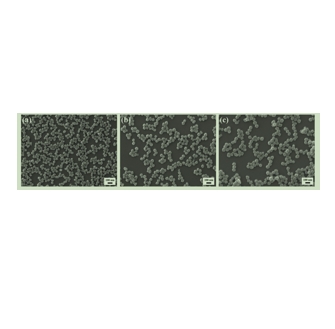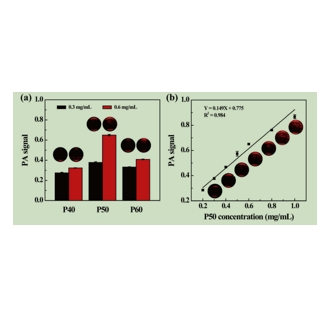文献:Theranostic nanoplatform based on polypyrrole nanoparticles for photoacoustic imaging and photothermal therapy
作者:Hui Liu ,Wenchao Li ,Yang Cao ,Yuan Guo ,Yuejun Kang
相关产品:5-FAM-NHS 5-羧基荧光-活性酯
原文摘要:Development of effective theranostic nanoplatforms against malignant tumor is still a challenge. With desirable near-infrared (NIR) lightresponsive properties, polypyrrole nanoparticles (PPy NPs) are one of the promising theranostic candidates for cancer photoacoustic imaging and photothermal therapy. Here, PPy NPs with distinct sizes were prepared using a facile aqueous dispersion polymerization method. The formed PPy NPs are uniform in size with narrow size distribution. Characterization data show that PPy NPs with a diameter around 50 nm (P50) display stronger absorption in the NIR range compared to 40 and 60 nm PPy NPs, which further influences their photo-responsive properties. Due to their higher NIR absorption, P50 NPs have better photoacoustic imaging property and photothermal conversion ability than the other two kinds of PPy NPs. The photothermal stability of P50 NPs was proved to be excellent. The CCK-8 assays show that PPy NPs have obvious acute cytotoxicity within 6 h and desirable cytocompatibility for longer incubation time (12 and 24 h). After 6-h incubation, P50 NPs could be internalized by HeLa cells. Their photothermal tumor ablation effect was demonstrated under 808-nm laser irradiation. These findings may provide in-depth understanding of the PPy-based multifunctional nanomaterials for the development of theranostic systems against cancer.
5-FAM-NHS,全称为5-羧基荧光素琥珀酰亚胺酯(5-Carboxyfluorescein Succinimidyl Ester),是一种常用于生物标记和荧光成像的试剂。5-FAM-NHS分子结构中包含荧光素部分和琥珀酰亚胺酯部分。荧光素部分赋予其荧光性质,而琥珀酰亚胺酯部分则具有与胺类化合物(如蛋白质、肽、核酸等)反应的能力,从而将这些生物分子标记上荧光。PPy NPs,即聚吡咯纳米颗粒(Polypyrrole Nanoparticles),是一种具有独特性能和应用的纳米材料。PPy NPs作为一种有机导电聚合物,具有良好的导电性能,这使得它在某些领域具有应用前景。5-FAM-NHS在很多领域有应用,例如5-FAM-NHS用于体外细胞有害性试验和细胞内定位研究。

图为:PPy NPs的水动力尺寸
5-FAM-NHS在体外细胞有害性试验和细胞内定位研究:
HeLa细胞和L929细胞(小鼠成纤维细胞系)使用添加胎牛血清和青霉素-链霉素的MEM培养基,氧化碳培养。采用CCK-8比色法定量不同浓度P50 NPs处理后的细胞活力。简单地说,将细胞接种到孔板中。一天后,用含有不同浓度P50 NPs的新鲜培养基替换培养基。用PBS缓冲液处理过的细胞也作为空白对照进行检测。培养后,除去培养基,用PBS缓冲液清洗每个孔。然后加入 CCK-8溶液,在正常培养条件下再培养。然后,用酶标仪记录每个孔的吸光度。对于每个样本,都报告了三口重复井的平均值和标准偏差。用不同浓度的P50 NPs处理后,用倒置显微镜观察细胞形态。然后,研究了P50 NPs的细胞摄取和定位。首先,使用聚多巴胺涂层法激活P50 NPs的表面。然后通过NHS对5- FAM与聚多巴胺上的氨基的化学连接,用5- FAM对NPs进行荧光标记。每百万分之一的修饰NPs与HeLa细胞孵育。然后,去除游离的NPs,用PBS缓冲液洗涤细胞。细胞核用Hoechst 33342染色。之后,使用共聚焦激光扫描显微镜观察细胞。

图为:PPy NPs的PA信号和图像
结论:采用简易水分散聚合法制备了PPy NPs。形成的PPy NPs呈均匀的球形,尺寸分布较窄。PPy NPs的尺寸对其对NIR的吸收有明显的影响,进而影响了其光声成像特性和光热转换能力。P50 NPs在三个形成的PPy NPs中表现出最佳的潜力。P50 NPs的光稳定性是理想的。CCK-8检测结果显示,PPy NPs表现出明显的急性细胞有害性,这需要在进一步的体内临床前研究中加以考虑。共聚焦图像显示,共孵育后,P50 NPs可被HeLa细胞内化到细胞质中。研究条件表明,P50 NPs对HeLa细胞的光热处理能力是有效的。本研究为基于PPy NPs的光声成像和光热Treatment 提供一个多功能纳米平台。

 2025-02-10 作者:lkr 来源:
2025-02-10 作者:lkr 来源:

